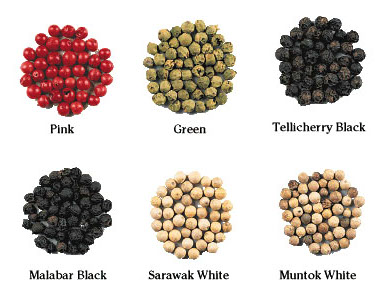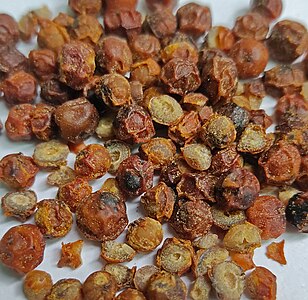Black pepper
| Black pepper | |
|---|---|

| |
| Pepper plant with immature peppercorns | |
| Scientific classification | |
| Kingdom: | Plantae |
| Clade: | Tracheophytes |
| Clade: | Angiosperms |
| Clade: | Magnoliids |
| Order: | Piperales |
| Family: | Piperaceae |
| Genus: | Piper |
| Species: | P. nigrum
|
| Binomial name | |
| Piper nigrum | |
Black pepper (Piper nigrum) is a flowering vine in the family Piperaceae, cultivated for its fruit (the peppercorn), which is usually dried and used as a spice and seasoning. The fruit is a drupe (stonefruit) which is about 5 mm (0.20 in) in diameter (fresh and fully mature), dark red, and contains a stone which encloses a single pepper seed. Peppercorns and the ground pepper derived from them may be described simply as pepper, or more precisely as black pepper (cooked and dried unripe fruit), green pepper (dried unripe fruit), or white pepper (ripe fruit seeds).[2]
Black pepper is native to the
Etymology
The word pepper derives from Old English pipor, Latin piper, and Greek: πέπερι.[6] The Greek likely derives from Dravidian pippali, meaning "long pepper".[7] Sanskrit pippali shares the same meaning.[6]
In the 16th century, people began using pepper to also mean the New World chili pepper (genus Capsicum), which is not closely related.[6]: 2b
Varieties

Processed peppercorns come in a variety of colours, any one of which may be used in food preparation, especially common peppercorn sauce.[8]
Black pepper
Black pepper is produced from the still-green, unripe
White pepper
White pepper consists solely of the seed of the ripe fruit of the pepper plant, with the thin darker-coloured skin (flesh) of the fruit removed. This is usually accomplished by a process known as retting, where fully ripe red pepper berries are soaked in water for about a week so the flesh of the peppercorn softens and decomposes; rubbing then removes what remains of the fruit, and the naked seed is dried. Sometimes the outer layer is removed from the seed through other mechanical, chemical, or biological methods.[10]
Ground white pepper is commonly used in
Green pepper
Green pepper, like black pepper, is made from unripe drupes. Dried green peppercorns are treated in a way that retains the green colour, such as with
.Fresh, unpreserved green pepper drupes are used in some cuisines like Thai cuisine and Tamil cuisine. Their flavour has been described as "spicy and fresh", with a "bright aroma."[11] They decay quickly if not dried or preserved, making them unsuitable for international shipping.
Red peppercorns
Red peppercorns usually consist of ripe peppercorn drupes preserved in brine and vinegar. Ripe red peppercorns can also be dried using the same colour-preserving techniques used to produce green pepper.[12]
Pink pepper and other plants
The bark of
-
Six variants of peppercorns (two types of white and two types of black, based on region)
-
Black and white peppercorns
-
Dried redKampot peppercorns
-
Close-up of a peppercorn
Plants

The pepper plant is a
Pepper can be grown in soil that is neither too dry nor susceptible to flooding, moist, well-drained, and rich in organic matter (the vines do not do well over an altitude of 900 m (3,000 ft) above sea level). The plants are propagated by cuttings about 40 to 50 cm (16 to 20 in) long, tied up to neighbouring trees or climbing frames at distances of about 2 m (6 ft 7 in) apart; trees with rough bark are favoured over those with smooth bark, as the pepper plants climb rough bark more readily. Competing plants are cleared away, leaving only sufficient trees to provide shade and permit free ventilation. The roots are covered in leaf mulch and manure, and the shoots are trimmed twice a year. On dry soils, the young plants require watering every other day during the dry season for the first three years. The plants bear fruit from the fourth or fifth year, and then typically for seven years. The cuttings are usually cultivars, selected both for yield and quality of fruit.[citation needed]
A single stem bears 20 to 30 fruiting spikes. The harvest begins as soon as one or two fruits at the base of the spikes begin to turn red, and before the fruit is fully mature, and still hard; if allowed to ripen completely, the fruits lose pungency, and ultimately fall off and are lost. The spikes are collected and spread out to dry in the sun, then the peppercorns are stripped off the spikes.[13]
Black pepper is native either to
Wild pepper grows in the
Production and trade
| Country | Production (tonnes) |
|---|---|
270,192
| |
114,749
| |
89,041
| |
66,000
| |
43,557
| |
33,348
| |
30,804
| |
| World | 747,644
|
Source:
FAOSTAT of the United Nations[17] | |
In 2020,
History
Black pepper is native to
The ancient history of black pepper is often interlinked with (and confused with) that of
Ancient times
Black peppercorns were found stuffed in the nostrils of Ramesses II, placed there as part of the mummification rituals shortly after his death in 1213 BCE.[27] Little else is known about the use of pepper in ancient Egypt and how it reached the Nile from the Malabar Coast of South Asia.
Pepper (both long and black) was known in Greece at least as early as the fourth century BCE, though it was probably an uncommon and expensive item that only the very rich could afford.

By the time of the early
With ships sailing directly to the Malabar coast, Malabar black pepper was now travelling a shorter trade route than long pepper, and the prices reflected it. Pliny the Elder's Natural History tells us the prices in Rome around 77 CE: "Long pepper ... is 15 denarii per pound, while that of white pepper is seven, and of black, four." Pliny also complains, "There is no year in which India does not drain the Roman Empire of 50 million sesterces", and further moralizes on pepper:
It is quite surprising that the use of pepper has come so much into fashion, seeing that in other substances which we use, it is sometimes their sweetness, and sometimes their appearance that has attracted our notice; whereas, pepper has nothing in it that can plead as a recommendation to either fruit or berry, its only desirable quality being a certain pungency; and yet it is for this that we import it all the way from India! Who was the first to make trial of it as an article of food? and who, I wonder, was the man that was not content to prepare himself by hunger only for the satisfying of a greedy appetite?
— Pliny, Natural History 12.14[29]
He does not state whether the 50 million was the actual amount of money which found its way to India or the total retail cost of the items in Rome, and, elsewhere, he cites a figure of 100 million sesterces.[28]
Black pepper was a well-known and widespread, if expensive, seasoning in the Roman Empire.
Postclassical Europe
Pepper was so valuable that it was often used as
A
I am black on the outside, clad in a wrinkled cover,
Yet within I bear a burning marrow.
I season delicacies, the banquets of kings, and the luxuries of the table,
Both the sauces and the tenderized meats of the kitchen.
But you will find in me no quality of any worth,
Unless your bowels have been rattled by my gleaming marrow.[33]
It is commonly believed that during the
Archaeological evidence of pepper consumption in late medieval Northern Europe comes from excavations on the Danish-Norwegian flagship, Gribshunden, which sank in the summer of 1495. In 2021, archaeologists recovered more than 2000 peppercorns from the wreck, along with a variety of other spices and exotic foodstuffs including clove, ginger, saffron, and almond. The ship was carrying King Hans to a political summit at the time of its loss. The spices were likely intended for feasts at the summit, which would have included the Danish, Norwegian, and Swedish Councils of State.[36][37]
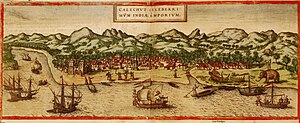
Its exorbitant price during the Middle Ages – and the monopoly on the trade held by Venice – was one of the inducements that led the Portuguese to seek a sea route to India. In 1498, Vasco da Gama became the first person to reach India by sailing around Africa (see Age of Discovery); asked by Arabs in Calicut (who spoke Spanish and Italian) why they had come, his representative replied, "we seek Christians and spices".[38] Though this first trip to India by way of the southern tip of Africa was only a modest success, the Portuguese quickly returned in greater numbers and eventually gained much greater control of trade on the Arabian Sea. The 1494 Treaty of Tordesillas granted Portugal exclusive rights to the half of the world where black pepper originated.
However, the Portuguese monopolized the spice trade for 150 years. Portuguese even became the lingua franca of the then known world. The spice trade made Portugal rich. However in the 17th century, the Portuguese lost most of their valuable Indian Ocean trade to the Dutch and the English, who, taking advantage of the Spanish rule over Portugal during the Iberian Union (1580–1640), occupied by force almost all Portuguese interests in the area. The pepper ports of Malabar began to trade increasingly with the Dutch in the period 1661–1663.7
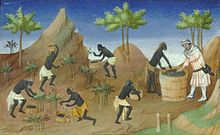
As pepper supplies into Europe increased, the price of pepper declined (though the total value of the import trade generally did not). Pepper, which in the early Middle Ages had been an item exclusively for the rich, started to become more of an everyday seasoning among those of more average means. Today, pepper accounts for one-fifth of the world's spice trade.[39]
China
It is possible that black pepper was known in
In the third century CE, black pepper made its first definite appearance in Chinese texts, as hujiao or "foreign pepper". It does not appear to have been widely known at the time, failing to appear in a fourth-century work describing a wide variety of spices from beyond China's southern border, including long pepper.[41] By the 12th century, however, black pepper had become a popular ingredient in the cuisine of the wealthy and powerful, sometimes taking the place of China's native Sichuan pepper (the tongue-numbing dried fruit of an unrelated plant).[citation needed]
Marco Polo testifies to pepper's popularity in 13th-century China, when he relates what he is told of its consumption in the city of Kinsay (Hangzhou): "... Messer Marco heard it stated by one of the Great Kaan's officers of customs that the quantity of pepper introduced daily for consumption into the city of Kinsay amounted to 43 loads, each load being equal to 223 lbs."[42]
During the course of the Ming treasure voyages in the early 15th century, Admiral Zheng He and his expeditionary fleets returned with such a large amount of black pepper that the once-costly luxury became a common commodity.[43]
Traditional medicine, phytochemicals, and research
Like many eastern spices, pepper was historically both a seasoning and a traditional medicine. Pepper appears in the Buddhist Samaññaphala Sutta, chapter five, as one of the few medicines a monk is allowed to carry.[44] Long pepper, being stronger, was often the preferred medication, but both were used. Black pepper (or perhaps long pepper) was believed to cure several illnesses, such as constipation, insomnia, oral abscesses, sunburn, and toothaches, among others.[45]
Pepper contains phytochemicals,[46] including amides, piperidines, and pyrrolidines.[47]
Pepper is known to cause sneezing. Some sources say that piperine, a substance present in black pepper, irritates the nostrils, causing the sneezing.[48] Few, if any, controlled studies have been carried out to answer the question.
Nutrition
One
Flavour
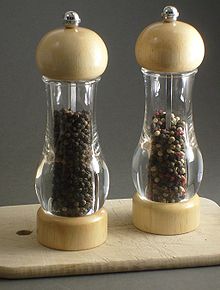
Pepper gets its spicy heat mostly from
Pepper loses flavour and aroma through evaporation, so airtight storage helps preserve its spiciness longer. Pepper can also lose flavour when exposed to light, which can
Enhancing the flavour profile of peppercorns (including piperine and essential oils), prior to processing, has been attempted through the postharvest application of ultraviolet-C light (UV-C).[57]
See also
![]() Media related to Piper nigrum at Wikimedia Commons
Media related to Piper nigrum at Wikimedia Commons
![]() Data related to Piper nigrum at Wikispecies
Data related to Piper nigrum at Wikispecies
![]() Pepper at the Wikibooks Cookbook subproject
Pepper at the Wikibooks Cookbook subproject
- False black pepper– Embelia ribes is a species in the family Primulaceae (the primrose family)
References
- ^ "Piper nigrum". Germplasm Resources Information Network. Agricultural Research Service, United States Department of Agriculture. Retrieved 2 March 2008.
- ^ a b c Harrison, Paul (27 January 2016). "What Are The Different Kinds of Peppercorns?". Food Republic. Retrieved 21 November 2019.
- ISBN 978-0-313-32487-1.
Peppers, called the king of spices, are the dried berries of a tropical vine native to Kerala, which is India's major producer
- ISBN 978-1-4262-1588-9.
- ^ (2018, February 6). These are the world’s three most traded spices. ITC. https://intracen.org/news-and-events/news/these-are-the-worlds-three-most-traded-spices
- ^ a b c "Pepper". Oxford English Dictionary (OED). Vol. 7 N–Poy (1 Corrected re-issue ed.). Oxford, UK: Oxford University Press. 1913. p. 663.
- OCLC 613210854.
- ^ Higgins, Edward (25 May 2015). "Where Do Peppercorns Come From?". Farmers' Almanac. Retrieved 2 May 2022.
- ^ a b "Why Is Pepper Black? – Know Your Pantry". knowyourpantry.com. 22 October 2021. Retrieved 24 May 2022.
- ^ "Cleaner technology for white pepper production". The Hindu Business line. 27 March 2008. Archived from the original on 9 May 2008. Retrieved 29 January 2009.
- ^ Ochef, Using fresh green peppercorns Archived 4 September 2011 at the Wayback Machine. Retrieved 6 November 2005.
- ^ Katzer, Gernot (2006). Pepper Archived 5 December 2012 at the Wayback Machine. Gernot Katzer's Spice Pages. Retrieved 2 December 2012.
- ^ a b "Black Pepper Cultivation and Harvest". Thompson Martinez. Archived from the original on 9 August 2014. Retrieved 14 May 2014.
- ^ "Piper nigrum Linnaeus". Flora of China.
- ^ PMID 11302858.
- ^ a b Manjunath Hegde, Bomnalli (19 October 2013). "Meet the pepper queen". Deccan Herald. No. Bangalore. Retrieved 22 January 2015.
- ^ a b "Pepper (piper spp.), World regions/Production/Crops for 2019 (from pick list)". Food And Agriculture Organization of the United Nations: Statistical Division (FAOSTAT). 2019. Retrieved 25 March 2021.
- ^ "Karvy's special Reports — Seasonal Outlook Report Pepper" (PDF). Karvy Comtrade Limited. 15 May 2008. Archived from the original (PDF) on 30 January 2018. Retrieved 29 January 2008.
- ISBN 978-1-84593-405-7.
- ISBN 978-981-283-791-2. Retrieved 28 March 2022.
- ^ J. Innes Miller, The Spice Trade of the Roman Empire (Oxford: Clarendon Press, 1969), p. 80
- ^ "Artefacts from the lost Port of Muziris." Archived 13 January 2016 at the Wayback Machine The Hindu. 3 December 2014.
- ^ "Muziris, at last?" Archived 23 July 2021 at the Wayback Machine R. Krishnakumar, www.frontline.in Frontline, 10–23 April 2010.
- ^ "Pattanam richest Indo-Roman site on Indian Ocean rim." Archived 13 January 2016 at the Wayback Machine The Hindu. 3 May 2009.
- ^ Prof. George Menachery; Fr. Werner Chakkalakkal, CMI (10 January 2001). "Cranganore: Past and Present". Kodungallur – The Cradle of Christianity in India. Archived from the original on 23 December 2013. Retrieved 11 May 2016.
- ^ Dalby, p. 93.
- ISBN 978-0-7565-3836-1. Retrieved 29 January 2008.
- ^ a b Young, p. 25.
- ^ From Bostock and Riley's 1855 translation. Text online Archived 23 March 2021 at the Wayback Machine.
- OCLC 669186315.
- ^ J. Norwich, Byzantium: The Early Centuries, 134
- ^ Innes Miller, The Spice Trade, p. 83
- ^ Translation from Turner, p 94. The riddle's answer is of course pepper.
- ^ Dalby, p. 156; also Turner, pp. 108–109, though Turner does go on to discuss spices (not pepper specifically) being used to disguise the taste of partially spoiled wine or ale.
- S2CID 21788355.
Spices, which are used as integral ingredients in cuisine or added as flavouring agents to foods, are present in insufficient quantities for their antimicrobial properties to be significant.
- PMID 36701280.
- ISSN 0065-101X.
- ^ Prasad, p. 3.
- ^ Jaffee, p. 10.
- ^ Dalby, pp. 74–75. The argument that jujiang was long pepper goes back to the fourth century CE botanical writings of Ji Han; Hui-lin Li's 1979 translation of and commentary on Ji Han's work makes the case that it was Piper nigrum.
- ^ Dalby, p. 77.
- ISBN 0-486-27587-6. p. 204.
- .
- ISBN 978-0-521-36708-0. Retrieved 29 January 2008.
- ^ Turner, p. 160.
- PMID 22352449.
- ISBN 978-0-8493-3620-1. Retrieved 29 January 2009.
- ^ U.S. Library of Congress Science Reference Services, "Everyday Mysteries", Why does pepper make you sneeze? Archived 31 October 2022 at the Wayback Machine. Retrieved 12 November 2005.
- ^ "Nutrition facts for black pepper, one tablespoon (6 g); USDA Nutrient Database, version SR-21". Conde Nast. 2014. Retrieved 25 October 2014.
- ^ Pepper. Tis-gdv.de. Retrieved on 31 October 2012.
- ISBN 978-1-4419-6488-5.
- PMID 12462618.
- PMID 16028995.
- PMID 18461962.
- ^ McGee, p. 428.
- OCLC 47231315. "Mill".
- PMID 29398783.
Bibliography
- Dalby, Andrew (2002). Dangerous Tastes. Berkeley: University of California Press. ISBN 978-0-520-23674-5.
- Davidson, Alan (2002). Wilder Shores of Gastronomy: Twenty Years of the Best Food Writing from the Journal Petits Propos Culinaires. Berkeley: Ten Speed Press. ISBN 978-1-58008-417-8.
- Holmes, Edward Morell (1885). . Encyclopædia Britannica. Vol. XVIII (9th ed.). pp. 516–517.
- Jaffee, Steven (2004). "Delivering and Taking the Heat: Indian Spices and Evolving Process Standards" (PDF). An Agriculture and Rural Development Discussion Paper. Archived from the original (PDF) on 3 March 2016. Retrieved 27 October 2005.
- McGee, Harold (2004). "Black Pepper and Relatives". On Food and Cooking (Revised ed.). Scribner. pp. 427–429. OCLC 56590708.
- Prasad, Anshuman (2003). "The Gaze of the Other: Postcolonial Theory and Organizational Analysis". In Prasad, Anshuman (ed.). Postcolonial Theory and Organizational Analysis: A Critical Engagement. New York: Palgrave Macmillan US. pp. 3–43. ISBN 978-1-4039-8229-2.
- Turner, Jack (2004). Spice: The History of a Temptation. London: Vintage Books. OCLC 61213802.
- Young, Gary K. (2001). Rome's Eastern Trade. Routledge. ISBN 0-415-24219-3.

